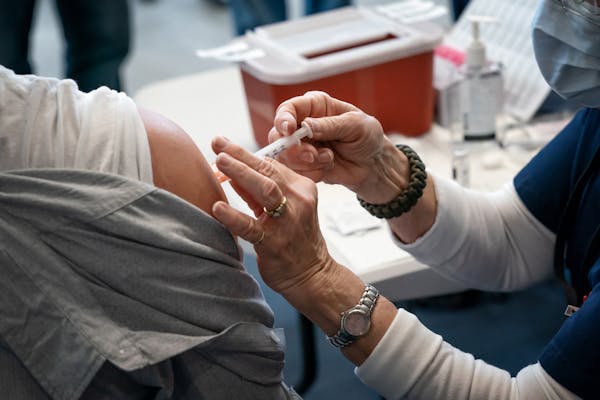Two influential COVID-19 models foresee pandemic activity headed in different directions this month in Minnesota, where state officials hope continued vaccinations will counter an increase in infections and hospitalizations.
The Institute for Health Metrics and Evaluation in Washington state on Friday predicted declining infections in Minnesota, even though mobile device usage data suggests more social interactions that are increasing opportunities for viral transmission.
However, Mayo Clinic's 14-day forecast predicts a mild increase in infections across the state, in part because of spring restlessness, said Dr. Sean Dowdy, Mayo's deputy chief value officer.
"COVID fatigue is as real as cold weather fatigue," he said. "It is getting warmer and Minnesotans want to socialize and be outside. This combined with the new variants has led to increased transmissibility."
More-infectious variants of the SARS-CoV-2 coronavirus continue to drive pandemic activity in Minnesota, which has reported 6,932 COVID-19 deaths and 537,828 diagnosed infections.
The totals include 10 deaths and 2,659 infections reported Friday by the Minnesota Department of Health — with the one-day case total being the highest since Jan. 4. The positivity rate of diagnostic testing increased to 6.6% — up from a low of 3.2% on March 2 — while the number of COVID-19 hospitalizations in Minnesota increased to 595.
State Health Commissioner Jan Malcolm said the rising numbers underscore the need for vaccination as well as continued public mask-wearing and social distancing.
"We really do consider this a race against time and against the variants," she said.
Health officials are encouraged that the rise hasn't caused a substantial increase in COVID-19 deaths. Vaccination of senior citizens and others at greatest risk of severe COVID-19 illness appears to be playing a protective role.
The state on Friday reported that 1,940,081 people in Minnesota had received a COVID-19 vaccine and that 1,285,925 of them had completed the one- or two-dose series.
That means that 44% of Minnesota's eligible population of people 16 or older, and more than 83% of senior citizens, have received vaccine.
A similar pattern of rising rates of positive tests, infections and hospitalizations played out in Minnesota in early fall 2020, right before a sharp increase in pandemic activity clogged up hospital beds across the state and resulted in the most lethal stretch in the pandemic.
Dowdy said a repeat scenario is doubtful this spring, and that a vaccination rate above 50% could lead to a reduction in restrictions on business and social activities.
While the current rate of vaccination is not enough to stem the rise in variant-driven cases entirely, "we don't expect the next peak to be anywhere close to as high as what we saw in Nov/Dec," he said in an e-mail. "If we can get to 50%, or even better 75%, I think we can think about life returning to 'normal.' "
Almost no infections are being found in southeast Minnesota in people 65 and older, he added. That age group was prioritized for vaccine after suffering 89% of Minnesota's COVID-19 deaths.
Minnesota ranks 14th in the U.S. for its per-capita rate of COVID-19 vaccinations but among the best in the nation for the percent of its available doses that have been administered.
The two-dose Pfizer and Moderna COVID-19 vaccines are considered about 95% protective against the development of COVID-19 illness, while the single-dose Johnson & Johnson vaccine is less protective against symptoms but equally protective against almost all COVID-related hospitalizations or deaths.
The state has identified 374 breakthrough cases of people testing positive for SARS-CoV-2 infections despite being fully vaccinated. Many cases were found through routine testing, including in long-term care facilities, and displayed no symptoms that indicated their infections.
Out of a total supply of more than 3.5 million doses, the state has reported that 713 have been wasted — often because vials were cracked in transport or were thawed and not used before the shelf life of the doses expired.
Gov. Tim Walz applauded Minnesota's progress on Friday, unveiling a vaccination site in Lino Lakes, the ninth operated by the state.
"The state's expansive network to bring vaccines directly to Minnesotans in their communities continues to grow," Walz said.
People 16 and older are encouraged to sign up on Minnesota's Vaccine Connector to be selected for shots at the site, though they also have a broadening array of pharmacy, clinic and local public health events available to them as well.
The B.1.1.7 variant is fueling as much as half of new infections in Minnesota and has been identified in outbreaks in youth sports events, sports clubs, restaurants and long-term care and correctional facilities, said Dr. Ruth Lynfield, state epidemiologist. Genomic sequencing of about 7% of positive test results has identified 1,573 infections involving that variant.
Roughly 4% of the known B.1.1.7 infections resulted in hospitalizations and five resulted in deaths.
Genomic sequencing also detected 337 infections involving two more infectious variants first identified in California. Only 18% of those infections involved people who had traveled, meaning transmission has been occurring in Minnesota, Lynfield said.
The state also has found five cases of the P.1 variant first identified in Brazil and 26 cases of the B1351 variant first identified in South Africa. At least two-thirds of these cases have involved international travel, but some people haven't been interviewed to determine the source of their infections.
"They are spreading," Lynfield said of the variants, "and we need to continue to be careful while more Minnesotans get vaccinated."
Jeremy Olson • 612-673-7744
Robbinsdale shelter-in-place alert accidentally sent countywide
Developer of St. Paul's Keg & Case food hall declares bankruptcy

Wildlife agency: Sturgeon won't go on endangered species list

Minnesotans interviewed to serve on Feeding Our Future trial

